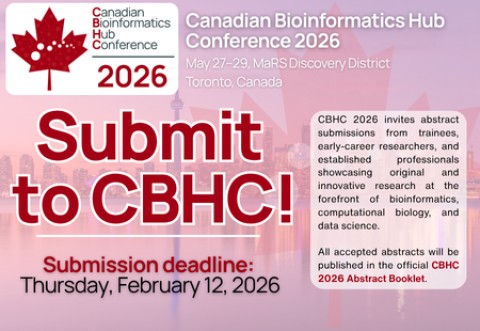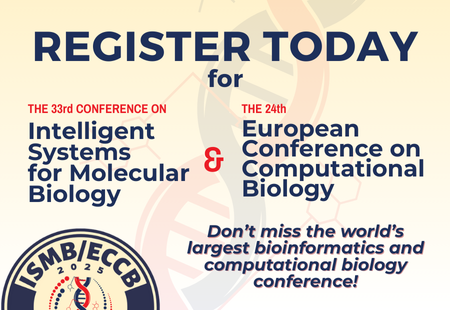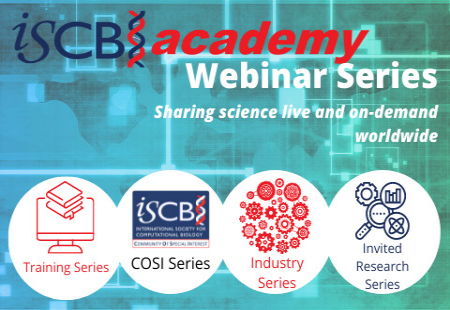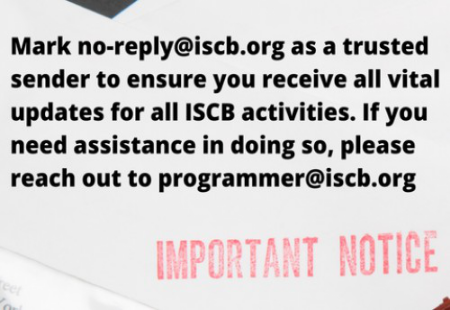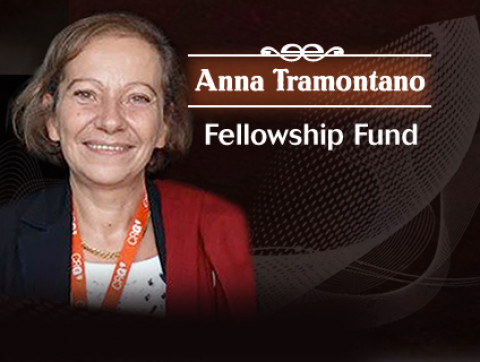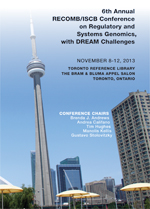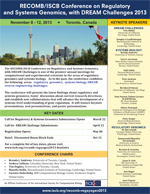| --> FRIDAY, NOVEMBER 08, 2013 |
| Links within this page: Saturday | Sunday | Monday | Tuesday |
|
| |
08:00 AM |
Registration |
| |
08:45 AM |
Opening Remarks: Gustavo Stolovitzky (IBM) |
| Chair: Julio Saez-Rodriguez (EBI) |
09:00 AM - 09:20 AM |
Challenge 1: HPN-DREAM Breast Cancer Network Inference Challenge: Inferring Causal Signaling Networks and Predicting Protein Phosphorylation Dynamics in Cancer, Laura Heiser (OHSU) and Steven Hill (NKI) |
| 09:20 AM - 09:30 AM |
Awards Challenge 1.
Presenters: Mark Wagar, President of Heritage Medical Systems (HPN) and Dan Gallahan, Deputy Director, Div. Cancer Biology (NCI) |
| 09:30 AM - 09:50 AM |
Ch1.1A Best Performer*: Team DC_TDC. Prophetic Granger Causality and the Role of a Biological Prior, Artem Sokolov (UC Santa Cruz) |
| 09:50 AM - 10:10 AM |
Ch1.2A Best Performer**: Team StochasticChaos. Prediction for Time-Course Proteomics In Vitro, Elana Fertig (JHU) |
| 10:10 AM - 10:30 AM |
Ch1.3 Best Performer: Team ABCD. BioWheel: A Visualization Tool for Proteomics, Amina Ann Qutub (Rice University) |
| 10:30 AM - 10:40 AM |
Challenge 1 discussion |
| |
10:40 AM - 11:10 AM |
Coffee Break & Poster Session |
| |
11:10 AM - 11:40 AM |
Keynote: Turning Networks Into Ontologies: Towards A Data-driven Gene Ontology, Trey Ideker, University of California, San Diego, United States |
Chair:
Rick Woychik (NIEHS) |
11:40 AM - 12:00 PM |
Challenge 2: NIEHS-NCATS-UNC DREAM Toxicogenetics Challenge: Overview and Results, Federica Eduati (EBI) and Fred Wright (NCSU) |
| 12:00 PM - 12:10 PM |
Awards Challenge 2. Presenter: Rick Woychik, Deputy Director (NIEHS) |
| 12:10 PM - 12:30 PM |
Ch2.1/Ch2.2 Best Performer: Teams YangLab/QBRC. Estimating Population-scale Toxicities for Environmental Chemicals from Genomic and Chemical Information, Tao Wang and Hao Tang (UTSW) |
| 12:30 PM - 12:50 PM |
Ch2.1 Second Best Performer: Team Cassis. Kernel Bilinear Regression for Toxicogenetics, Elsa Bernard (Inst. Curie) |
| 12:50 PM - 13:00 PM |
Challenge 2 discussion |
| |
13:00 PM - 14:30 PM |
Lunch & Poster Session |
| |
14:30 PM - 15:00 PM |
Keynote: DNA and RNA Binding Motifs for Mapping Gene Regulation, Tim Hughes, University of Toronto, Canada |
Chair:
Markus Covert (Stanford University) |
15:00 PM - 15:20 PM |
Challenge 3: A Crowd-sourced Approach to Whole-cell Model Parameter Estimation, Markus Covert (Stanford Univ) and Pablo Meyer (IBM) |
| 15:20 PM - 15:30 PM |
A Computational Platform for the DREAM Whole Cell Parameter Estimation Challenge, Brandon Allgood (Numerate Inc.) |
| 15:40 PM - 15:40 PM |
Awards Challenge 3.
Presenter: Pablo Meyer (IBM Research) |
| 15:40 PM - 16:00 PM |
Ch3.1 Best Performer: Team Crux. Parameter Estimation for Huge Systems,
Clemens Kreutz (University of Freiburg) |
| 16:00 PM - 16:20 PM |
Ch3.2 Best Performer: Team Whole-Sale Modelers. Parameter Fitting as Statistical Inference: An Outsider's Perspective, Alex H Williams (Brandeis Univ.) |
| |
16:20 PM - 16:30 PM |
Challenge 3 discussion |
| |
16:30 PM - 17:00 PM |
Coffee Break & Poster Session |
| |
17:00 PM - 17:20 PM |
Future Challenges: Paul Boutros (OICR) and Gustavo Stolovitzky (IBM Research) |
| |
17:20 PM - 18:00 PM |
Discussion: The Future of DREAM (All) |
| |
18:00 PM |
Adjourn |
| * Due to Agenda Constraints, Team NMSUSongLab (the best performer in Ch1.1B and the most consistent performer through Ch1.1A and Ch1.1B) will be presenting their contribution in a Poster Presentation DREAM Poster 09). Presenters: Yang Zhang and Joe Song (NMSU) |
| ** Due to Visa Issues the originally scheduled presentation by Team GuanLab (the co-best performer in Ch1.2A): Network Time-Course Projection Using Truncated SVD, Fan Zhu (University of Michigan) has been cancelled, and replaced with the presentation by Team StochchasticChaos. |
| ** Due to Agenda Constraints, Team CGR (the best performer in Ch1.2B will be presenting their contribution in a Poster Presentation (DREAM Poster 08). Presenter: Chunhua Yan |
| - To the Top - |
| -->SATURDAY, NOVEMBER 09, 2013 - SYSTEMS BIOLOGY |
|
| |
08:00 AM |
Registration |
| |
08:45 AM |
Opening Remarks |
Chair:
Andrea Califano
(Columbia University) |
09:00 AM - 09:30 AM |
Keynote: Building Protein Networks to Understand Human Disease: Ciliopathies Explain Retinal Degeneration, Obesity, and Cancer, Peter Jackson, Stanford University School of Medicine, United States |
| 09:35 AM - 09:50 AM |
Evolution After Whole-genome Duplication: A Network Perspective, Luay Nakhleh, Rice University, United States |
| 09:50 AM - 10:05 AM |
Rational Optimization of Computational Biology Pipelines, Nicholas Harding, OICR, Canada
|
| 10:05 AM - 10:20 AM |
Global Linkage Map Connects Meiotic Centromere Function to Chromosome Size in Budding Yeast, Anastasia Baryshnikova, Princeton University, United States |
| 10:20 AM - 10:35 AM |
Mapping Trigenic Interactions of Whole Genome Duplicates in Yeast, Elena Kuzmin , University of Toronto |
| |
10:35 AM - 11:00 AM |
Coffee Break |
Chair:
Trey Ideker
(UC, San Diego)
|
11:00 AM - 11:30 AM |
Keynote: Peter Sorger,Harvard Medical School, United States |
| 11:30 AM - 11:45 AM |
Systematic Exploration of Autonomous Modules in Noisy MicroRNA-target Networks for Testing the Generality of the ceRNA Hypothesis, Kevin Y. Yip, The Chinese University of Hong Kong |
| 11:45 AM - 12:00 PM |
Ensemble Inference and Inferability of Gene Regulatory Networks, S M Minhaz Ud-Dean, ETH Zurich, Switzerland |
| 12:00 PM - 12:15 PM |
A Nutrient-responsive Pathway that Determines M Phase Timing Through Control of B-cyclin mRNA Stability, Vincent Messier, CCBR, Canada |
| |
12:15 PM - 13:30 PM |
Lunch & Poster Session |
Chair:
Gustavo Stolovitsky
(IBM Research) |
13:30 PM - 14:00 PM |
Keynote: Tony Pawson and Modular Biology: From Domains to Cell Signalling Systems
by Dr. Jeff Wrana, Mount Sinai Hospital, Canada |
| 14:05 PM - 14:20 PM |
A Computational High-throughput Approach to discover Post-translational Modulators of Transcription Factor Activity from Gene Expression Profiles, Diego Di Bernardo, Telethon Institute of Genetics and Medicine, Italy |
| 14:20 PM - 14:35 PM |
Exploring the Dynamic Interplay of Human miRNA-Transcription Factor Regulatory Cycles, Daniel Chee, University of Washington, United States |
| 14:35 PM - 14:50 PM |
Localized Enzymes Reflect Cellular metabolic state, Pablo Meyer, IBM, United States |
| 14:50 PM - 15:05 PM |
Next Generation Insight into Signaling Networks: A Systematic Protein-protein Interaction Reporter Assay to Identify Upstream Regulators of Signaling Hubs, Marie Filteau, Laval University, Canada |
| |
15:05 PM - 15:30 PM |
Coffee Break |
Chair:
Laura Heiser
(Oregon Health and Science University)
|
15:30 PM - 15:45 PM |
The Mutational landscape of Phosphorylation Signaling in Cancer, Juri Reimand, University of Toronto, Canada |
| 15:45 PM - 16:00 PM |
A 13C-based Method for Metabolic Flux Measurement and Prediction in Genome-Scale Models, Hector Garcia Martin, Lawrence Berkeley National Laboratory, United States |
| 16:00 PM - 16:30 PM |
Keynote: Predictive Uses of Metabolic Reconstructions, Berhnard Palsson,University of California, San Diego, United States |
| - To the Top - |
| -->SUNDAY, NOVEMBER 10, 2013 - SYSTEMS BIOLOGY |
|
| |
08:00 AM |
Registration |
| |
08:45 AM |
Opening Remarks |
Chair:
Brenda Andrews
(University of Toronto)
|
09:00 AM - 09:30 AM |
Keynote: Olivier Pourquié, Université de Strasbourg, France |
| 09:35 AM - 9:50 AM |
Elucidating Influenza Inhibition Pathways via Network Reconstruction, Arnon Mazza, Tel Aviv University, Israel |
| 09:30 AM - 10:05 AM |
Quantification of Cell-to-cell Variability in Protein Spatial Spread from Fluorescence Microscopy of Unsynchronized Budding Yeast, Louis-Francois Handfield, University of Toronto, Canada |
| 10:05 AM - 10:20 AM |
Validation of Vertebrate Developmental Phenotype Predictions using Zebrafish, Garbiel Musso, Brigham and Women's Hospital / Harvard Medical School, United States |
| 10:20 AM - 10:35 AM |
The Regulatory Landscape of Human Fetal Development, Kyle Siebenthall, University of Washington, United States |
| |
10:35 AM - 11:00 AM |
Coffee Break |
Chair:
Michael White
(Washington University School of Medicine) |
11:00 AM - 11:30 AM |
Keynote: From Phenotypes to Pathways: Global Exploration of Cellular Networks Using Yeast Functional Genomics, Brenda Andrews,University of Toronto, Canada |
| 11:30 AM - 11:45 AM |
Transcript Level and Sequence Determinants of Protein Abundance and Noise in Escherichia coli, Joao C. Guimaraes, University of California, Berkeley, United States |
| 11:45 AM - 12:00 PM |
Dissecting the Regulatory Machinery of Neurodegeneration in an In Vitro Model of ALS, Mariano J. Alvarez, Columbia University, United States |
| 12:00 PM - 12:15 PM |
Combinatorial Regulation of Lipoprotein Lipase by MicroRNAs During Mouse Adipogenesis, Maria Bouvy-Liivrand, University of Luxembourg |
| |
12:15 PM - 13:30 PM |
Lunch & Poster Session |
Chair:
Josh Stuart
(UC, Santa Cruz) |
13:30 PM - 14:00 PM |
Keynote: Levi A. Garraway, Dana-Farber Cancer Institute and the Broad Institute, United States |
| 14:05 PM - 14:20 PM |
A Network-based Approach for Drug Synergy Prediction from Gene Expression Data, Andrea Califano, Columbia University, United States |
| 14:20 PM - 14:35 PM |
Identifying Drug Mechanism of Action using Network Dysregulation, Mukesh Bansal, Columbia University, United States |
| 14:35 PM - 14:50 PM |
Dynamic Analysis of Cellular Differentiation and Drug Mode of Action Using Large-scale, Real time 3D Living Cell Arrays, Beatriz Penalver Bernabe, Northwestern University, United States |
| 14:50 PM - 15:05 PM |
Chemogenomic Profiling Reveals a Network of the Cellular Responses to Small Molecules, Anna Y Lee, University of Toronto, Canada |
| |
15:05 PM - 15:30 PM |
Coffee Break |
Chair:
Jason Enst
(UCLA) |
15:30 PM - 15:45 PM |
Discovering Latent Cancer Characteristics Predictive of Drug Sensitivity, David A. Knowles, Stanford University, United States |
| 15:45 PM - 16:00 PM |
Integrated Profiling of p53 Wild-type Cell Lines Identifies Differentially Responsive Populations and a Gene Expression Signature that Predicts Sensitivity to SAR299155, a Potent and Selective Disruptor of the p53-MDM2 Interaction, Stephen Rowley, Sanofi, United States |
| 16:00 PM - 16:15 PM |
L1000 Expression Signatures Reveal the Landscape of Ligand and Drug Response in Breast Cancer Cell Lines, Marc Hafner, Harvard Medical School, United States |
| 16:15 PM - 16:45 PM |
Keynote: Reconstructing Regulatory Circuits: Lessons from Immune Cells, Aviv Regev, Broad Institute, United States |
| |
16:45 PM - 19:00 PM |
Reception at Appel Salon – Sponsored by the University of Toronto’s Donnelly Center |
| |
- To the Top - |
| -->MONDAY, NOVEMBER 11, 2013 - REGULATORY GENOMICS |
|
| |
08:00 AM |
Registration |
| |
08:45 AM |
Opening remarks |
Chair:
Tim Hughes, (University of Toronto) |
09:00 AM - 09:30 AM |
Keynote: Algorithms in Nature, Ziv Bar-Joseph, Carnegie Mellon University, United States |
| 09:35 AM - 09:50 AM |
Understanding the Synonymous Information Encoded in Transcripts via Evolutionary Systems Biology and Synthetic Biology Approaches, Tamir Tuller, Tel Aviv University, Israel |
| 09:50 AM - 10:05 AM |
The Functional Potential Score: Integrating Comparative, Population and Functional Genomic Data to Identify Recent Selective Pressure in Noncoding Human DNA, Brad Gulko, Cornell University, United States |
| 10:05 AM - 10:20 AM |
Primate Transcript and Protein Expression Levels Evolve under Compensatory Selection Pressures, Zia Khan, University of Chicago, United States |
| 10:20 AM - 10:35 AM |
The Accessible Chromatin Landscape of the Mouse Genome Reveals a Core Mammalian Regulon, Jeff Vierstra, University of Washington-Seattle, United States |
| |
10:35 AM - 11:00 AM |
Coffee Break |
Chair:
Ziv Bar-Joseph (Carnegie Mellon University) |
11:00 AM - 11:30 AM |
Keynote: Encoding Cellular Information Through p53 Dynamics in Individual Cells, Galit Lahav, Harvard Medical School, United States |
| 11:30 AM - 11:45 AM |
Linking Signaling Pathways To Transcriptional Response In Breast Cancer, Hatice Ulku Osmanbeyoglu, Memorial Sloan–Kettering Cancer Center, United States |
| 11:45 AM - 12:00 PM |
Systematic Detection and Analysis of Epigenomic Changes During Melanoma Cancer Progression, Petko Fiziev, University of California, Los Angeles, United States |
| 12:00 PM - 12:15 PM |
Gata3 and Runx3 Binding Underlies Differential Nucleosome Organization in Helper and Cytolytic T Cells, Matthew E. Pipkin, The Scripps Research Institute, United States |
| |
12:15 PM - 13:30 PM |
Lunch & Poster Session |
Chair:
Jason Ernst (UCLA) |
13:30 PM - 14:00 PM |
Keynote: Reduce, Reuse, Recycle: The Dynamics of Regulatory Information Usage in Development, Jason D. Lieb, Princeton University, United States |
| 14:05 PM - 14:20 PM |
Distinct and Predictive Histone Lysine Acetylation Patterns at Promoters, Enhancers and Gene Bodies, Nisha Rajagopal, University of California, San Diego, United States |
| 14:20 PM - 14:35 PM |
Poly-dA:dT tracts form a Directional Nucleosomal Turnstile In Vivo, Carl de Boer, University of Toronto, Canada |
| 14:35 PM - 14:50 PM |
Condition-specific Binding of the Glucocorticoid Receptor, Morgane Thomas-Chollier, Institut de Biologie de l'Ecole Normale Supérieure, France |
| 14:50 PM - 15:05 PM |
Genome-wide Analysis of Functional and Evolutional Features of Tele-enhancers, Huang Di, National Institutes of Health, United States |
| |
15:05 PM - 15:30 PM |
Coffee Break |
Chair:
Terry Furey (University of North Carolina at Chapel Hill)
|
15:30 PM - 15:45 PM |
Integrative and Parallel Approaches to Uncover Drivers of Cancer, Uri David Akavia, McGill University, Canada |
| 15:45 PM - 16:00 PM |
Cardiac Enhancers Harbor Undiscovered Genetic Variants Associated with Heart Contraction Traits, Xinchen Wang, Massachusetts Institute of Technology, United States |
| 16:00 PM - 16:15 PM |
Conserved Combinatorial Transcription Factor Binding Identifies Regulatory Variants in Human Disease Pathways, Michael D. Wilson, SickKids Research Institute, Canada |
| 16:15 PM - 16:45 PM |
Mentoring Session: Regulatory Genomics and Systems Biology in Industry: Opportunities and Challenges. Presenters: Monica Boyle, Dart NeuroScience LLC; Andrea Califano, Columbia University; Boris Hayete, GNS; Raquel Norel, IBM Research; Ravi Pandya, Microsoft Research; Stephen Rowley, Sanofi |
| - To the Top - |
| -->TUESDAY, NOVEMBER 12, 2013 - REGULATORY GENOMICS |
|
| |
08:00 AM |
Registration |
| |
08:45 AM |
Opening Remarks |
Chair:
Manolis Kellis (MIT) |
09:00 AM - 09:30 AM |
Keynote: From Genome Function to Personalised Omics, Emmanouil (Manolis) Dermitzakis, University of Geneva Medical School, Switzerland |
| 09:35 AM - 09:50 AM |
Analysis of Non-coding Genetic Variants Impact on Gene Regulation and Complex Traits, Roger Pique-Regi, Wayne State University, United States |
| 09:50 AM - 10:05 AM |
Finding Alternative eQTLs by Exploring Sparse Model Space, Xinghua Shi, University of North Carolina at Charlotte, United States |
| 10:05 AM - 10:20 AM |
The Impact of Natural Genetic Variation on Protein and RNA Networks, Andreas Beyer, University of Cologne, Germany |
| 10:20 AM - 10:35 AM |
Novel Trans-eQTL Analysis Demonstrates Effect of Population Genetic Architecture on Detecting and Interpreting Regulatory Associations, Terrence Furey, University of North Carolina at Chapel Hill, United States |
| |
10:35 AM - 11:00 AM |
Coffee Break |
|
Chair:
Christina Leslie (MSKCC)
|
11:00 AM - 11:30 AM |
Keynote: Genome-wide Analysis of Protein-DNA Interactions, Jussi Taipale, Karolinska Institutet, Sweden |
| 11:30 AM - 11:45 AM |
System Wide Analyses have Underestimated Transcriptional Importance in Animals, Jingyi Jessica Li, University of California, Los Angeles, United States |
| 11:45 AM - 12:00 PM |
Mapping Functional Transcription Factor Networks from Gene Expression Data, Michael R. Brent, Washington University, United States |
| 12:00 PM - 12:15 PM |
Integrating Gene Expression and Sequence Data with Existing Biological Knowledge to Model Context-specific Gene Regulation, Sofia Kyriazopoulou-Panagiotopoulou, Stanford University, United States |
| |
12:15 PM - 13:30 PM |
Lunch & Poster Session |
Chair:
Roger Pique-Regi
(Wayne State University)
|
13:30 PM - 14:00 PM |
Keynote: The Transcriptome of Drosophila Melanogaster, Brenton R. Graveley, University of Connecticut Health Center, United States |
| 14:00 PM - 14:20 PM |
Determination and Inference of Eukaryotic Transcription Factor Sequence Specificity, Matt Weirauch, Cincinnati Children's Hospital, United States |
| 14:20 PM - 14:35 PM |
Informational Requirements for Transcriptional Regulation, Ivan Erill, University of Maryland Baltimore County, United States |
| 14:35 PM - 14:50 PM |
Widespread Evidence for DNA Shape Dependent Transcription-factor Binding Preferences, Iris Dror, Technion, Israel |
| 14:50 PM - 15:05 PM |
Analysis of C2H2 Transcription Factor Binding Sites Using a High-throughput ChIP-seq Approach, Frank W. Schmitges, University of Toronto, Canada |
| |
15:05 PM - 15:30 PM |
Coffee Break |
|
Chair:
Amy Caudy
(University of Toronto)
|
15:30 PM - 15:45 PM |
Comprehensive Quantification of Transcription Factor Thermodynamics and Kinetics for Both Specific and Nonspecific Binding Modes on a High-Throughput Sequencer, Robin Friedman, Institut Pasteur, France |
| 15:45 PM - 16:00 PM |
Using Reporter Synthetic Genetic Array (R-SGA) Analysis to Explore Transcriptional Regulatory Pathways in Budding Yeast, Hendrikje Goettert, University of Toronto, Canada |
| 16:00 PM - 16:15 PM |
A Massively Parallel In Vivo Enhancer Assay Reveals that Highly Local Features Determine the Cis-regulatory Function of ChIP-seq Peaks, Michael A. White, Washington University, United States |
| |
16:15 PM - 16:45 PM |
Conference Wrap-up,
Top 10 Announcements, Survey Results |
|
| - To the Top - |

